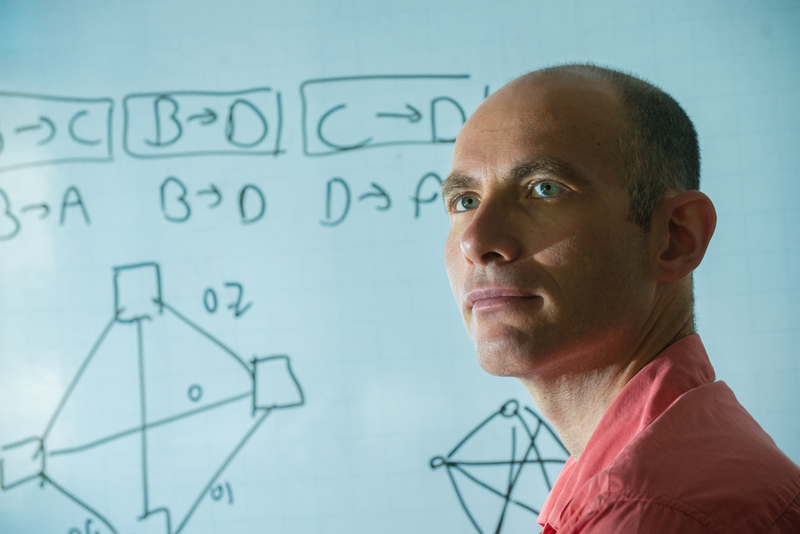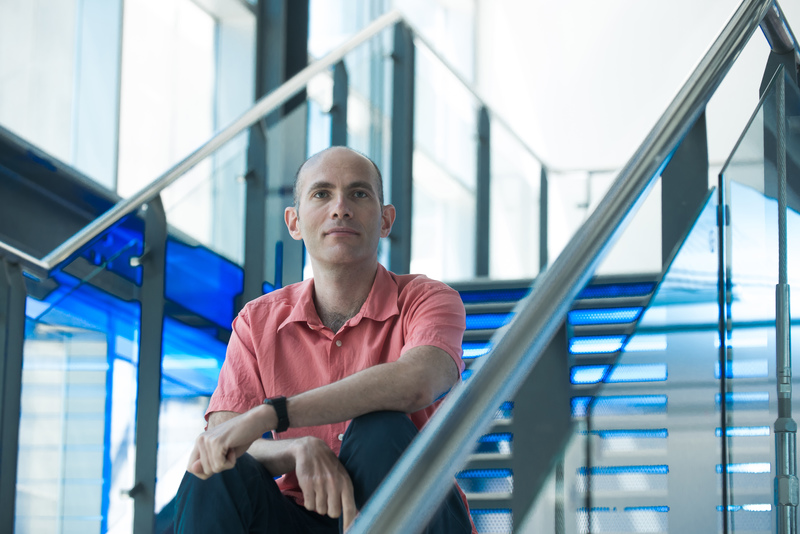" My vision is of 'heterogeneous collaborative systems' that combine the computational powers of computers with the reasoning ability of people for the benefit of all participants."
When Dr. Ya'akov (Kobi) Gal first began his undergraduate studies, he had a hard time making up his mind about what to study. On the one hand, he was keenly interested in technology and computer science; “My Dad worked for IBM Israel and I thought that was cool; I wanted to follow in his footsteps."
On the other hand, he was fascinated by human behavior and psychology. “I always wanted to know, what makes people tick? What drives decision making, how do human beings think and act differently—and how much of this behavior can be attributed to cultural and societal effects?"

His third passion was teaching and education. He explains that “schools should be places where students are given a chance to explore in open-ended learning environments that provide the tools they need to solve real problems, not just compete for grades."
As a result, Gal began his studies in Bar Ilan University's psychology department, but also studied computer science and statistics as minors. “I was convinced that I would find a way to integrate these disparate fields that fascinated me, although I didn't have a clue how to go about this task. It was only later that I learned to combine insights from these different fields to better understand human psychology and predict behavior, and to create computer-assisted learning environments for advancing education."
After completing his undergraduate degree, Gal spent about ten years in Cambridge, MA, first as a graduate student at Harvard University studying artificial intelligence (AI), and later as a postdoctoral researcher at the Massachusetts Institute of Technology and Harvard University where he combined AI techniques with methods from the learning sciences.
“After almost ten fruitful years in the U.S., I was ready to come back to Israel to apply the tools and methods I learned in the U.S. I was very happy to be able to join BGU's Department of Information Systems Engineering."
Gal's long-term research goal is to create computer programs (known as “computer agents") that learn to cooperate with people by integrating techniques from the computational and social sciences. “In the 1960s and '70s, many scientists thought that AI would replace human intellect with machines, just as the industrial revolution replaced physical labor with machines," explains Gal. “That didn't happen, because humans have qualities that cannot be replicated by computers such as intuition and creativity. My vision is of 'heterogeneous collaborative systems' that combine the computational powers of computers with the reasoning ability of people for the benefit of all participants."
Gal provides two examples that demonstrate the concept of collaborative systems. The first involves negotiation between people and computers. “Negotiations are endemic to human behavior," says Gal, “from give-and-take interactions in our daily lives to international diplomatic negotiations. When a 17-year-old new driver wants to borrow the family car and Mom agrees to give it to him on the condition that he does the grocery shopping in the local supermarket – that is also a form of negotiation."
Gal created computer agents that observe how humans negotiate in a simple laboratory game. These agents are then able to learn and adapt to human negotiating styles and traits, such as upholding promises and willingness to divulge information to others during the negotiation process.
“In one study," explains Gal, “we discovered that Americans tend to be more reliable in carrying out their promises and in trusting others too much. Therefore they were unsuccessful negotiators in getting what they want." Gal uses these insights to build computer agents that choose their negotiation strategies by predicting human behavior. “I hope that in the near future, intelligent computer agents will be able to train human negotiators."
In the example above he says, “Such agents can demonstrate that it might be advantageous for reliable trusting parties to adopt incremental, trust-building negotiation methods instead. For example, they could give away only a portion of their resources up front and wait for the other side to do the same before continuing to the next stage."

Another project involves “virtual laboratories" (software) for students in schools –educational software that supports the creation of models of the world, running them, generating data and analyzing the results. Gal is skeptical of the traditional school model where the teacher lectures to the students, then tests them to see if they learned the material by rote. “This method induces learning-for-the-test, instead of the acquisition of real knowledge and study skills that students can apply to new challenges and problems," he says. Instead, in these virtual laboratories, the children solve problems (in physics, chemistry, etc.) by doing what scientists do: creating hypotheses and testing them, experimenting and using trial and error.
“This method has the added advantage that it can be used as long-distance learning in places where qualified teachers are not always available," continues Gal. “However, the disadvantage is that even when teachers are available, they cannot realistically peep through the keyholes to observe all the children in their problem-solving sessions in order to help them." Therefore, Gal has created an algorithm running in the background that figures out how he or she is trying to solve the problem. If the student gets stuck, the program will intervene and guide him or her intelligently by providing the right amount of information at the appropriate point in time. Then the agent will summarize each child's capabilities and learning strengths and weaknesses, for the teacher.
In this collaborative system, says Gal, “we provide support to both teachers and students. For students, the support consists of intelligent analysis of their activities with virtual laboratories. For teachers, this support consists of visualization methods that increase their understanding of how students learn."
Gal won the 2014 Krill Prize for academic excellence among young Israeli scientists, granted annually by the Wolf Foundation. He considers himself fortunate to be able to conduct research combining technology and human behavior, and also teach probability theory, artificial intelligence and machine-learning.
“I love teaching as much as I love research and science," he says. “And I try to implement my pedagogic vision in the college classroom. My courses are discussions, not monologues; the students are active participants and engaged in the learning process, not passive bystanders." For example, Gal says, he uses the “flipped classroom principle," where the students study the basic material at home, in the form of online lectures or material, and then assimilate the material and experiment together in the classroom (learning by doing). “We all enjoy it!" he says.
“The student population at BGU is different than in other Israeli universities," he continues. “Our students come from all over the country because of their strong social awareness and desire to have an impact on society and the environment. Here, the university campus doesn't empty out at 6:00 pm. It is really special to teach these students."
Gal is also passionate about engaging minority disenfranchised populations in education. In the BGU-Beer-Sheva context, he is interested in bringing long-distance learning to the Bedouins, particularly those living in unrecognized villages. He is currently involved in a project that would involve distributing tablet computers that can be used by students in villages not connected to the electrical grid. Smart technology would be installed in the tablets so that the children can study even without a teacher. “I truly believe in the importance of the human teaching factor but when that's not available, technology is the next best alternative," he says.
